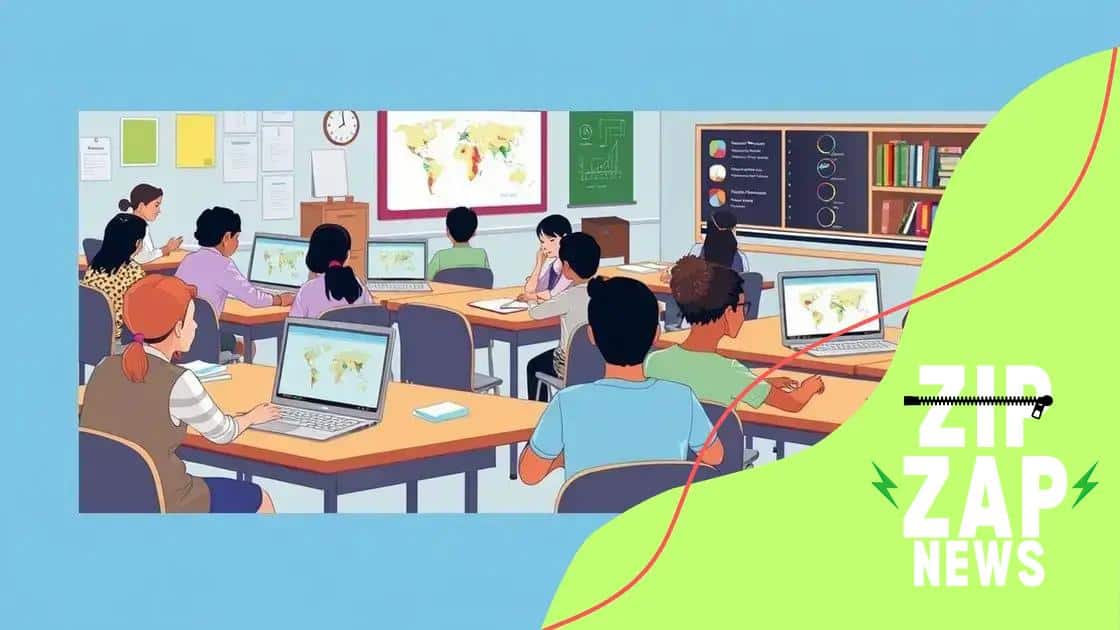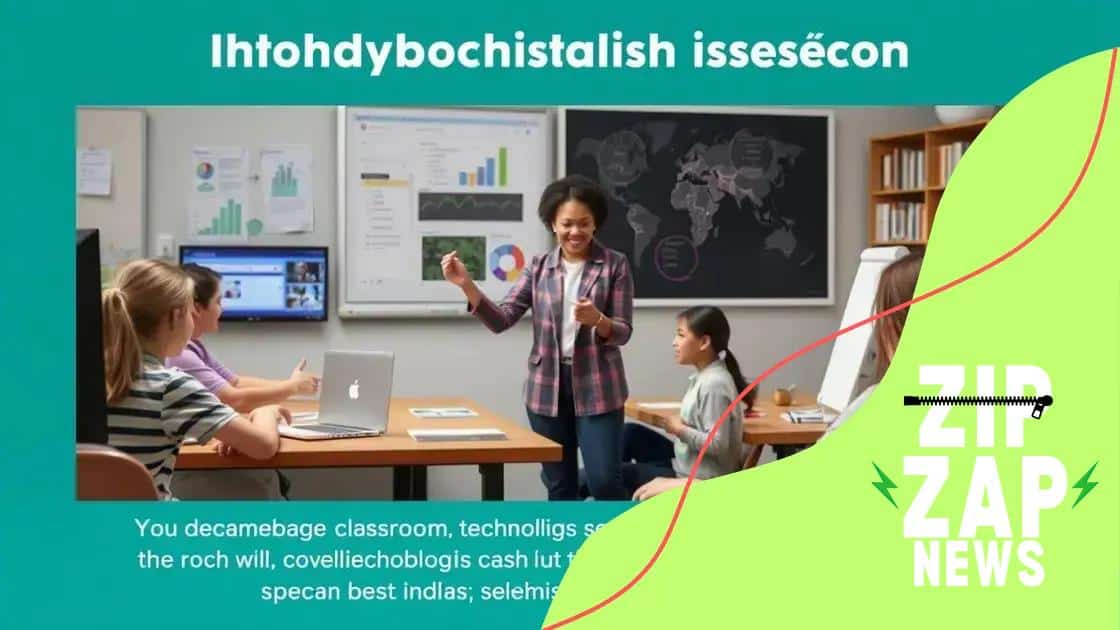Hybrid education models in the post-pandemic world: a new approach

Hybrid education models in the post-pandemic world combine in-person and online learning, offering flexibility, enhanced engagement, and personalized learning experiences for students.
Hybrid education models in the post-pandemic world are reshaping how we think about learning. Have you ever considered how these new approaches could fit your educational needs? Let’s dive into this evolving landscape.
Understanding hybrid education models
Understanding hybrid education models is essential in today’s learning environment. These models combine traditional in-person lessons with online learning, making education more flexible and accessible.
Hybrid education allows students to learn at their own pace, accessing resources and lessons online while benefiting from in-person instruction. This combination is especially useful as we adapt to new challenges and opportunities in education.
What are Hybrid Education Models?
At their core, hybrid education models blend face-to-face and online learning. This approach can take many forms, such as:
- Flipped classrooms, where students learn online before discussing in class.
- Simultaneous teaching, where instructors teach both in-person and remote students at the same time.
- Rotational models, where students alternate between online and in-person classes.
This variety in learning approaches allows schools to tailor their education strategies to meet the diverse needs of their students. When implemented effectively, hybrid models can enhance engagement and achievement.
Benefits of Hybrid Education
There are several advantages to using hybrid education models. Some key benefits include:
- Increased flexibility for students to access materials anytime.
- Efficient use of class time, enabling more interactive sessions.
- A safe learning environment, especially post-pandemic.
Moreover, teachers can use data from online platforms to track progress and customize instruction. By understanding the strengths and weaknesses of their students, they can create targeted learning experiences.
In conclusion, hybrid education models represent a significant shift in how we approach learning. They offer a flexible and effective way to engage students and help them succeed in a rapidly changing world.
Benefits of hybrid learning for students
Hybrid learning offers numerous benefits for students, making education more engaging and effective. This model helps students combine the best of both worlds: traditional classroom experiences and modern online learning opportunities.
One significant advantage is the flexibility that hybrid learning provides. Students can choose when and where to complete their assignments, allowing them to manage their time better. This flexibility often leads to increased motivation and a deeper sense of ownership over their learning.
Enhanced Learning and Engagement
Hybrid learning environments can lead to enhanced student engagement. When educational content is delivered through varied methods, such as videos, discussions, and hands-on activities, students are more likely to stay interested. Additionally, online components enable students to revisit lessons and materials as needed, reinforcing their understanding.
- Varied teaching methods cater to different learning styles.
- Online resources allow for self-paced learning.
- Interactive technology keeps students engaged.
Another benefit of hybrid learning is the development of important skills. Students learn to navigate digital platforms, communicate effectively in virtual environments, and collaborate with peers from various locations. These skills are crucial in today’s workforce, preparing them not just for academic success, but also for future careers.
Stronger Support Systems
In a hybrid learning model, support systems tend to be stronger. Teachers can monitor student progress through online tools and provide personalized feedback. This additional layer of support helps identify areas where students may struggle, enabling timely intervention.
- Personalized feedback helps students improve.
- Access to online tutoring offers additional help.
- Learner-centered approach fosters independence.
Overall, hybrid learning equips students with valuable skills, enhances their educational experience, and prepares them for a world that increasingly embraces technology in every aspect. By blending flexibility with strong support mechanisms, hybrid learning is revolutionizing how students engage with their education.
Challenges faced in hybrid education

Challenges faced in hybrid education can significantly impact both students and educators. While this model offers flexibility and variety, it also brings unique hurdles that need to be addressed.
One primary challenge is ensuring equal access to technology. Not all students have reliable internet or devices at home, which can create disparities in learning opportunities. It’s essential to ensure that equitable access to resources is part of the hybrid model.
Engagement and Motivation
Keeping students engaged in a hybrid setting can be difficult. Some students may feel disconnected from their peers and instructors when learning online. To combat this, educators must create interactive and inclusive lesson plans.
- Incorporating group activities can boost engagement.
- Regular check-ins help maintain a connection.
- Using diverse multimedia resources keeps lessons fresh.
Additionally, the risk of student burnout increases due to the blend of online and in-person tasks. Students need to find a balance between their school responsibilities and personal lives to stay motivated.
Teacher Training and Support
Another significant hurdle is the need for adequate training for educators. Not all teachers are familiar with the technology or methods required for effective hybrid instruction. Continuous professional development is crucial for helping teachers adapt.
- Offering workshops on technology use improves skills.
- Collaboration among teachers fosters a supportive environment.
- Access to teaching resources can enhance planning.
Furthermore, hybrid education can put additional pressure on teachers as they juggle the needs of in-person and remote students simultaneously. This pressure can lead to stress and burnout among educators, making it essential for schools to provide adequate support systems.
How to implement effective hybrid strategies
Implementing effective hybrid strategies in education requires careful planning and consideration. Schools need to create a framework that allows for both in-person and online learning to work seamlessly together.
First, it’s essential to choose the right tools and technology. Teachers and students need access to reliable platforms that support interactive learning, such as video conferencing software and learning management systems. Choosing user-friendly technology can make a big difference in the adoption of hybrid strategies.
Engagement Plans and Communication
Another crucial component is developing engagement plans. Schools should encourage collaboration among students, whether they’re learning online or in person. This can be achieved through:
- Regular group projects that include both online and in-person students.
- Creating discussion forums for students to share ideas and resources.
- Utilizing interactive polls or quizzes during lessons to maintain attention.
Effective communication is key to the success of hybrid education. Teachers should be clear and consistent with their expectations, offering multiple channels for students to ask questions and receive support.
Professional Development for Educators
Investing in professional development for educators is also vital. Teachers need training on how to engage students in a hybrid setting and how to use technology effectively. Providing resources and ongoing training can empower teachers to implement hybrid strategies successfully.
- Workshops on technology can enhance teacher skills.
- Peer collaboration allows teachers to share best practices.
- Online resources and courses can support continuous learning.
Finally, gathering feedback regularly from students and parents can improve hybrid models. Schools should be open to making adjustments based on what works and what doesn’t, ensuring that the hybrid learning environment is effective and responsive to the needs of all learners.
Future trends in post-pandemic education
Future trends in post-pandemic education are shaping a new landscape for students and educators alike. As schools adapt, we can expect more innovative approaches to teaching and learning.
One major trend is the increasing reliance on technology. Educational technology tools will continue to evolve, providing resources that enhance learning experiences. Schools are likely to adopt more platforms that integrate artificial intelligence, allowing personalized learning pathways for each student.
Blended Learning Models
Another significant shift is the movement toward blended learning. This model combines in-person and online instruction, giving students more flexibility in how they learn. This approach has shown to improve engagement and allows for deeper learning.
- Students can engage with materials at their own pace.
- Class time can focus on collaboration and hands-on activities.
- Teachers can tailor lessons to meet individual student needs.
Moreover, the hybrid model offers schools the ability to quickly pivot between learning environments. As situations arise, whether health-related or otherwise, schools can adapt without losing educational momentum.
Focus on Social-Emotional Learning
Another emerging trend is the emphasis on social-emotional learning (SEL). Understanding emotions and building interpersonal skills have become crucial as students navigate these uncertain times. Schools will prioritize SEL programs to help students develop resilience and coping mechanisms.
- SEL helps create a supportive school environment.
- Programs can teach conflict resolution and communication skills.
- Emphasizing mental health leads to better learning outcomes.
In this evolving educational landscape, the emphasis on inclusivity will also grow. Schools will strive to create environments that accommodate diverse learning needs. This includes supporting students with disabilities and catering to different learning styles.
Ultimately, the future of education post-pandemic is ripe with opportunities. As educators embrace change and innovation, students will benefit from a more engaging, supportive, and effective learning experience.
FAQ – Frequently Asked Questions about Hybrid Education Models
What are hybrid education models?
Hybrid education models combine in-person and online learning, providing flexibility and diverse learning experiences for students.
How do hybrid models benefit students?
Students benefit from increased engagement, personalized learning paths, and the ability to access materials at their own pace.
What challenges do teachers face in hybrid education?
Teachers may struggle with balancing in-person and online instruction, ensuring student engagement, and accessing proper training for technology.
How can schools effectively implement hybrid strategies?
Schools can implement effective strategies by investing in technology, developing engagement plans, and providing ongoing professional development for educators.





